Page 17 of 27
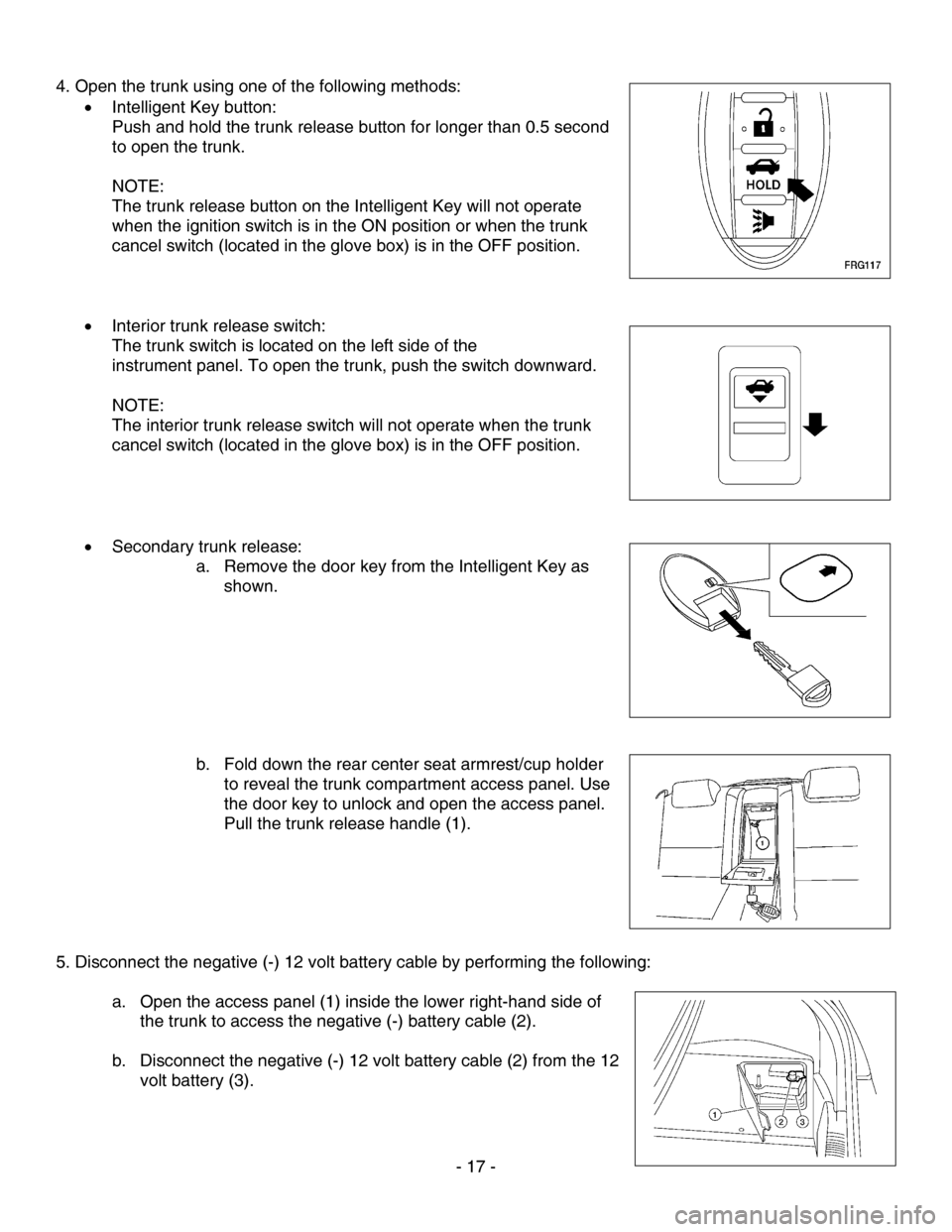
4. Open the trunk using one of the following methods:
• Intelligent Key button:
Push and hold the trunk release button for longer than 0.5 second
to open the trunk.
NOTE:
The trunk release button on the Intelligent Key will not operate
when the ignition switch is in the ON position or when the trunk
cancel switch (located in the glove box) is in the OFF position.
• Interior trunk release switch:
The trunk switch is located on the left side of the
instrument panel. To open the trunk, push the switch downward.
NOTE:
The interior trunk release switch will not operate when the trunk
cancel switch (located in the glove box) is in the OFF position.
• Secondary trunk release:
a. Remove the door key from the Intelligent Key as
shown.
b. Fold down the rear center seat armrest/cup holder
to reveal the trunk compartment access panel. Use
the door key to unlock and open the access panel.
Pull the trunk release handle (1).
5. Disconnect the negative (-) 12 volt battery cable by performing the following:
a. Open the access panel (1) inside the lower right-hand side of
the trunk to access the negative (-) battery cable (2).
b. Disconnect the negative (-) 12 volt battery cable (2) from the 12
volt battery (3).
- 17 -
Page 18 of 27
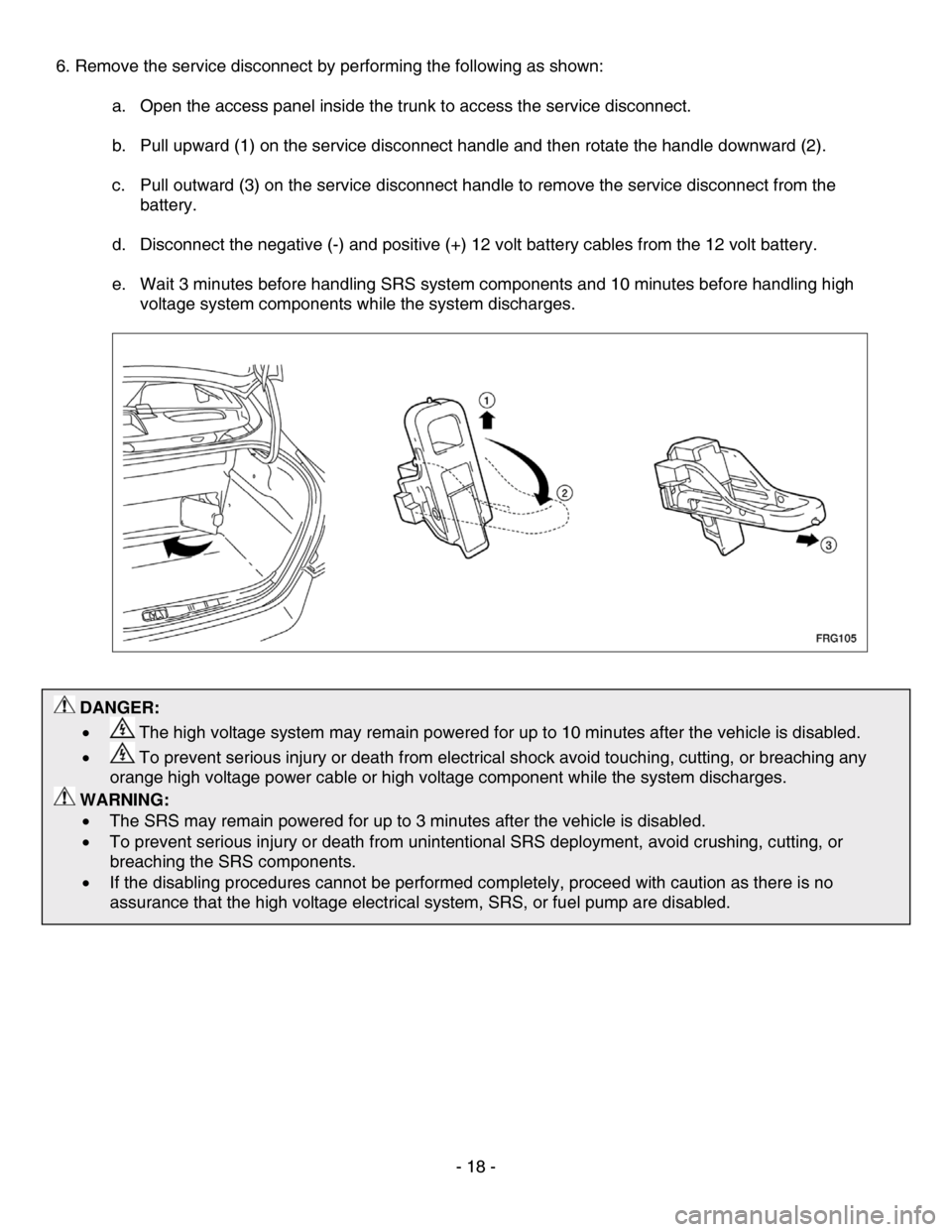
6. Remove the service disconnect by performing the following as shown: a. Open the access panel inside the trunk to access the service disconnect.
b. Pull upward (1) on the service disconnect handle and then rotate the handle downward (2).
c. Pull outward (3) on the service disconnect handle to remove the service disconnect from the
battery.
d. Disconnect the negative (-) and positive (+) 12 volt battery cables from the 12 volt battery\
.
e. Wait 3 minutes before handling SRS system components and 10 minutes before handling high
voltage system components while the system discharges.
DANGER:
•
The high voltage system may remain powered for up to 10 minutes after the vehicle is disabled.
•
To prevent serious injury or death from electrical shock avoid touching, cutting, or breaching any
orange high voltage power cable or high voltage component while the system discharges.
WARNING:
• The SRS may remain powered for up to 3 minutes after the vehicle is disabled.
• To prevent serious injury or death from unintentional SRS deployment, avoid crushing, cutting, or
breaching the SRS components.
• If the disabling procedures cannot be performed completely, proceed with caution as there is no
assurance that the high voltage electrical system, SRS, or fuel pump are disabled.
- 18 -
Page 19 of 27
Alternative High Voltage System Shut Down Procedure
NOTE:
If the service disconnect procedure cannot be performed, the following alternative shut down procedure is
acceptable.
A. Locate the fuse/fusible link box (1) under the hood near the driver
side strut tower (2).
• : Vehicle Front
- 19 -
B. Remove the fuse/fusible link box cover and remove the IGCT 50
amp fusible link (1) from the fuse/fusible link box (2). If the correct fuse
cannot be recognized, pull all the fuses in the fuse/fusible link box.
Page 20 of 27
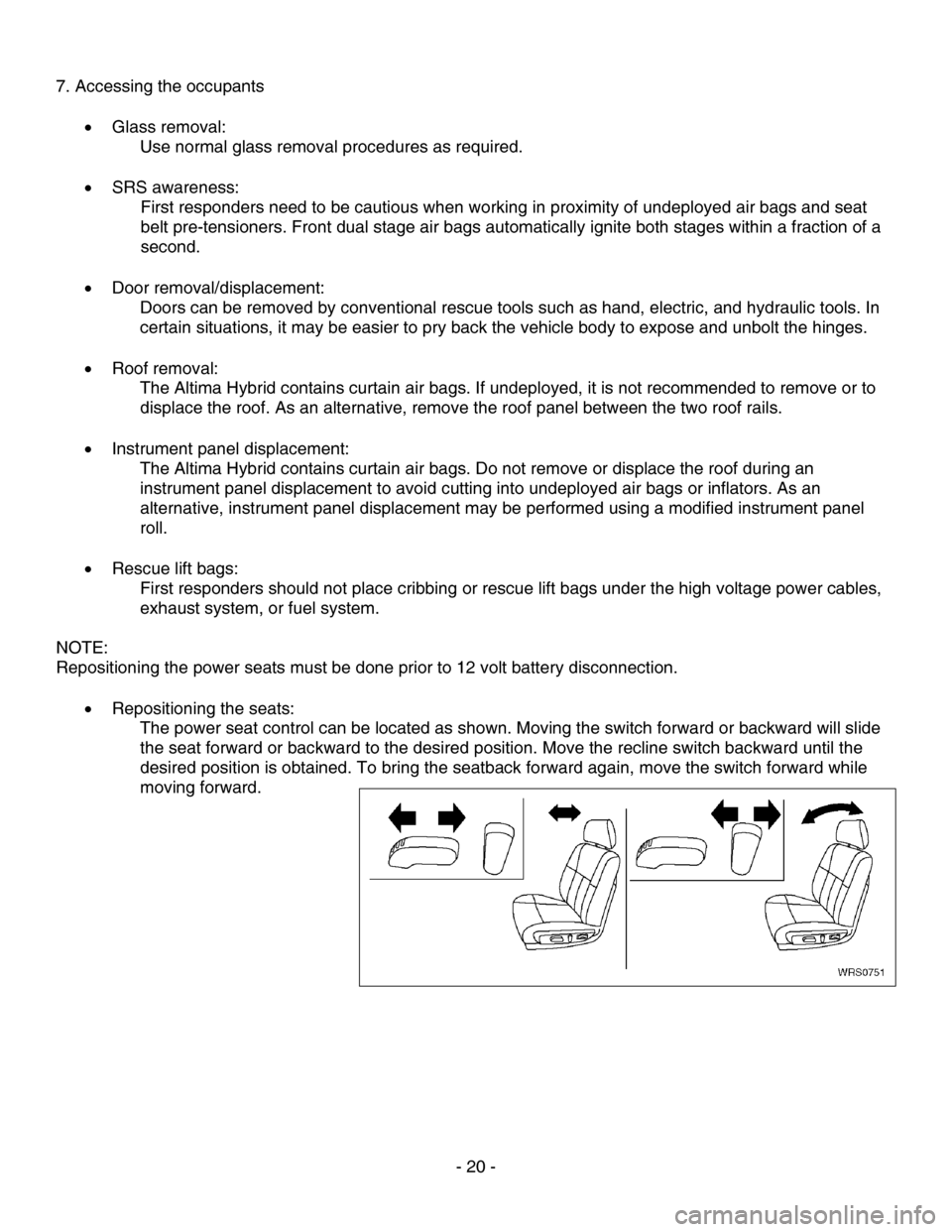
7. Accessing the occupants
• Glass removal:
Use normal glass removal procedures as required.
• SRS awareness:
First responders need to be cautious when working in prox imity of undeployed air bags and seat
belt pre-tensioners. Front dual stage air bags automatically ignite both stages within a fraction of a
second.
• Door removal/displacement:
Doors can be removed by conventional rescue tools such as hand, electric, and hydraulic tools. In
certain situations, it may be easier to pry back the vehicle body to expose and unbolt the hinges.
• Roof removal:
The Altima Hybrid contains curtain air bags. If undeployed, it is not recommended to remove or to
displace the roof. As an alternative, remove the roof panel between the two roof rails.
• Instrument panel displacement:
The Altima Hybrid contains curtain air bags. Do not remove or displace the roof during an instrument panel displacement to avoid cutting into undeployed air bags or inflators. As an
alternative, instrument panel displacement may be performed using a modified instrument panel
roll.
• Rescue lift bags:
First responders should not place cribbing or rescue lift bags under the high voltage power cables,
exhaust system, or fuel system.
NOTE:
Repositioning the power seats must be done prior to 12 volt battery disconnection.
• Repositioning the seats:
The power seat control can be located as shown. Moving the switch forward or backward will slide
the seat forward or backward to the desired position. Move the recline switch backward until the
desired position is obtained. To bring the seatback forward again, move the switch forward while
moving forward.
- 20 -
Page 21 of 27
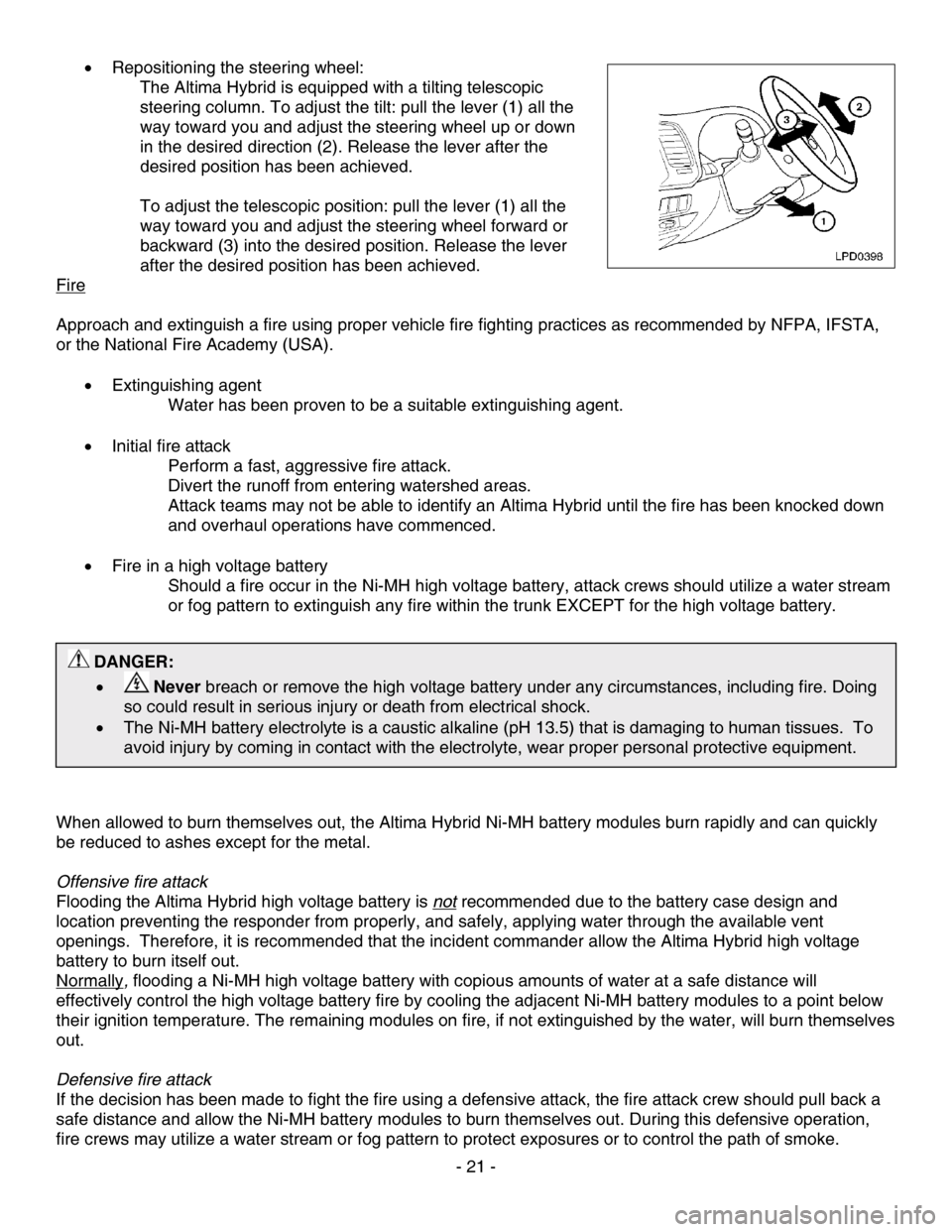
• Repositioning the steering wheel:
The Altima Hybrid is equipped with a tilting telescopic
steering column. To adjust the tilt: pull the lever (1) all the
way toward you and adjust the steering wheel up or down
in the desired direction (2). Release the lever after the
desired position has been achieved.
To adjust the telescopic position: pull the lever (1) all the
way toward you and adjust the steering wheel forward or
backward (3) into the desired position. Release the lever
after the desired position has been achieved.
Fire
Approach and extinguish a fire using proper vehicle fire fighting practices as recommended by NFPA, IFSTA,
or the National Fire Academy (USA).
• Extinguishing agent
Water has been proven to be a suitable extinguishing agent.
• Initial fire attack
Perform a fast, aggressive fire attack.
Divert the runoff from entering watershed areas.
Attack teams may not be able to identify an Altima Hybrid until the fire has been knocked down
and overhaul operations have commenced.
• Fire in a high voltage battery
Should a fire occur in the Ni-MH high voltage battery, attack crews should utilize a water stream
or fog pattern to extinguish any fire within the trunk EXCEPT for the high voltage battery.
DANGER:
•
Never breach or remove the high voltage battery under any circumstances, including fire. Doing
so could result in serious injury or death from electrical shock.
• The Ni-MH battery electrolyte is a caustic alkaline (pH 13.5) that is damaging to human tissues. To
avoid injury by coming in contact with the electrolyte, wear proper personal protective equipment.
When allowed to burn themselves out, the Altima Hybrid Ni-MH battery modules burn rapidly and can quickly
be reduced to ashes except for the metal.
Offensive fire attack
Flooding the Altima Hybrid high voltage battery is not
recommended due to the battery case design and
location preventing the responder from properly, and safely, applying water through the available vent
openings. Therefore, it is recommended that the incident commander allow the Altima Hybrid high voltage
battery to burn itself out.
Normally
, flooding a Ni-MH high voltage battery with copious amounts of water at a safe distance will
effectively control the high voltage battery fire by cooling the adjacent Ni-MH battery modules to a point below
their ignition temperature. The remaining modules on fire, if not extinguished by the water, will burn themselves
out.
Defensive fire attack
If the decision has been made to fight the fire using a def ensive attack, the fire attack crew should pull back a
safe distance and allow the Ni-MH battery modules to burn themselves out. During this defensive operation,
fire crews may utilize a water stream or fog pattern to protect exposures or to control the path of smoke.
- 21 -
Page 22 of 27

- 22 -
Overhaul
During overhaul, immobilize and disable the vehicle if not already done. Refer to the high voltage electrical
system disable procedure located in Extrication. The high voltage battery cover should
never be breached or
removed under any circumstances, including fire. Doing so may result in severe electrical burns, shock and/or
electrocution.
Recovery/recycling of the Ni-MH high voltage battery
Clean up of the high voltage battery can be accomplished by the vehicle recovery crew without further concern
of runoff or spillage. For information regarding recycling of the high voltage battery, contact the nearest Nissan
dealer or Nissan customer assistance at: United States: 1-800-NISSAN-1 (1-800-647-7261) or in Canada:
1-800-387-0122.
Spills
The Altima Hybrid contains the same common automotive fluids used in other non-hybrid Nissan vehicles, with
the exception of the Ni-MH electrolyte used in the high voltage battery. The Ni-MH battery electrolyte is a
caustic alkaline (pH 13.5) that is damaging to human tissues. The electrolyte, however, is absorbed in the cell
plates and should not normally spill or leak out even if a battery module is cracked. Both the metal battery case
and the plastic battery modules could be breached if a catastrophic crash occurred.
To neutralize a lead-acid battery electrolyte spill, a diluted boric acid solution or vinegar can be used to
neutralize a Ni-MH battery electrolyte spill similar to the use of baking soda.
NOTE:
Electrolyte leakage from the high voltage battery is unlikely due to the battery construction and the amount of
available electrolyte contained within the Ni-MH modules. Any spillage would not warrant a declaration as a
hazardous material incident. First responders should follow the recommendations as outlined in this
emergency response guide.
In an emergency, Nissan Material Safety Data Sheets (MSDS) are available by contacting:
United States: CHEMTREC at 1-800-424-9300
Canada: CANUTEC at *666 or 1-613-996-6666 (collect)
• Handle Ni-MH electrolyte spills using the following personal protective equipment:
�¾ Splash shield or safety goggles (fold down helmet shields are not acceptable for acid or alkaline
electrolyte spills)
�¾ Insulated rubber gloves
�¾ Acid-resistant apron
�¾ Insulated rubber boots
�¾ Insulated rubber mats (for connect/disconnect of high voltage battery)
• Neutralize Ni-MH electrolyte
�¾ Use a diluted boric acid solution or vinegar.
�¾ Boric acid solution = 800 grams boric acid to 20 liters water or 5.5 ounces boric acid to 1 gallon
of water.
Page 23 of 27
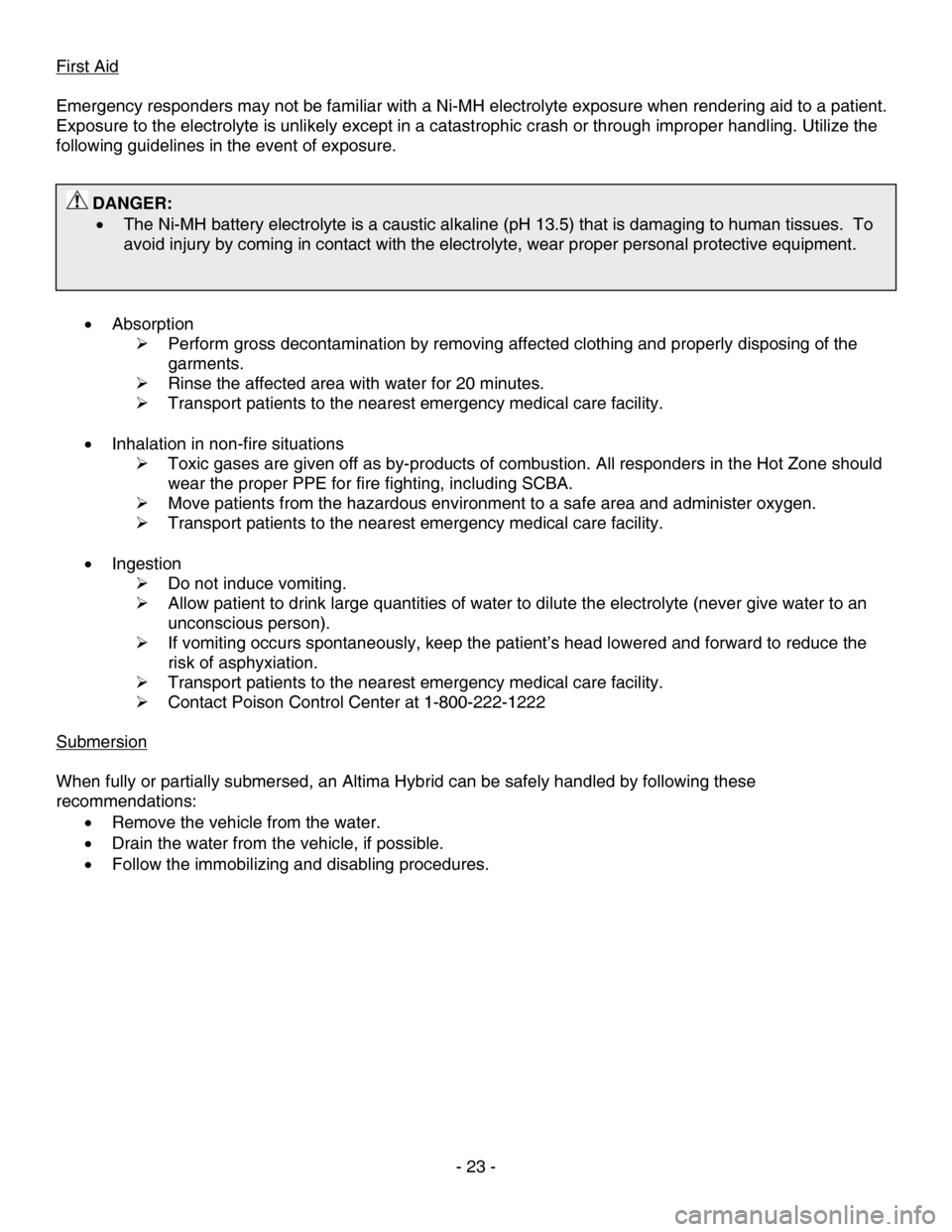
First Aid
Emergency responders may not be familiar with a Ni-MH electrolyte exposure when rendering aid to a patient.
Exposure to the electrolyte is unlikely except in a catastrophic crash or through improper handling. Utilize the
following guidelines in the event of exposure.
DANGER:
• The Ni-MH battery electrolyte is a caustic alkaline (pH 13.5) that is damaging to human tissues. To
avoid injury by coming in contact with the electrolyte, wear proper personal protective equipment.
• Absorption
�¾ Perform gross decontamination by removing affected clothing and properly disposing of the
garments.
�¾ Rinse the affected area with water for 20 minutes.
�¾ Transport patients to the nearest emergency medical care facility.
• Inhalation in non-fire situations
�¾ Toxic gases are given off as by-products of combustion. All responders in the Hot Zone should
wear the proper PPE for fire fighting, including SCBA.
�¾ Move patients from the hazardous environment to a safe area and administer oxygen.
�¾ Transport patients to the nearest emergency medical care facility.
• Ingestion
�¾ Do not induce vomiting.
�¾ Allow patient to drink large quantities of water to dilute the electrolyte (never give water to an
unconscious person).
�¾ If vomiting occurs spontaneously, keep the patient’s head lowered and forward to reduce the
risk of asphyxiation.
�¾ Transport patients to the nearest emergency medical care facility.
�¾ Contact Poison Control Center at 1-800-222-1222
Submersion
When fully or partially submersed, an Altima Hybrid can be safely handled by following these
recommendations:
• Remove the vehicle from the water.
• Drain the water from the vehicle, if possible.
• Follow the immobilizing and disabling procedures.
- 23 -
Page 24 of 27

Roadside Assistance
Nissan Altima Hybrid roadside assistance may be handled like conventional Nissan vehicles, except as noted
in the following pages.
Towing
The Altima Hybrid is a front wheel drive vehicle and it must be towed with the front wheels off the ground.
Failure to do so may cause serious damage to the hybrid system components.
• A flat bed trailer is the preferred method of towing.
• When towing the vehicle, be sure to release the parking brake.
• The vehicle may be shifted out of P (Park) into N (Neutral) by turning the ignition ON, depr\
essing the
brake, and then moving the shift lever to N (Neutral).
• If the shift lever cannot be moved out of P (Park), a shift release button is provided near the shift lever.
To use the shift release button, perform the following:
a. Remove the shift lock cover as shown.
b. Insert a small screwdriver in the shift lock release slot and
push down.
c. Move the shift lever to the N (Neutral) position while holding
down the release button.
Fuel-Filler Door Opener
The fuel-filler door release is located on the floor to the left of the
driver’s seat. To open the fuel filler door, pull upward on the release
lever. There may be a delay up to 15 seconds before the fuel-filler
door opens.
Spare Tire
The jack (1), tools (2), and spare tire are provided in the trunk.
- 24 -